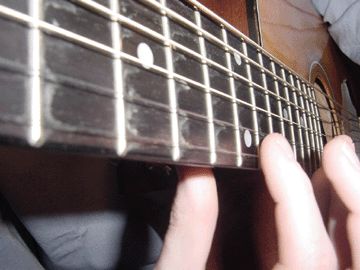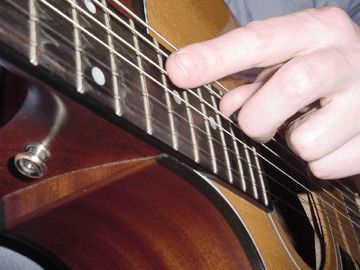Usually in the very early stages of the guitarist's learning process, one of the first "tricks" he/she is taught is the use of harmonics, in particular "natural harmonics." Unfortunately, many players think that this technique is one dimensional and the experimentation stops there but in this lesson you'll learn not only how to play different types of harmonics but also how to also push the envelop and combine various other techniques (or "tricks") to enhance your repertoire. Below is a breakdown for several uses of harmonics, which range in difficulty from beginner to advanced. The model we'll use to demonstrate this technique will be the Emajor(add11) chord. In order to proceed to the next step, you should be able to perform the previous step(s) with relative ease. Some of these exercises sound better with a clean sound and some are easier to execute with a distorted sound. Experiment and see what works best for you. Start slow, get the technique underneath your fingers and then apply it. Here's your Emaj(add11) chord to get you started:

1. Natural Harmonics: this technique is performed by gently placing the fleshy part of the bottom of your fret hand index finger directly over the fretboard (as opposed to placing your fingers firmly on the fretboard between the frets) and striking the open string. At the very moment the string is played, remove your fret hand from the string. You should hear the harmonic ring out. These harmonics work on any string at any fret but most players use the 12th, 7th, 5th and 3rd frets to achieve this sound. Examples of "natural harmonics" can be found at the 02:36-02:38 mark of Stevie Ray Vaughan's version of "Little Wing" and the 00:17-00:19 mark of the Black Crows' "She Talks To Angels."

2. Pinch Harmonics: like all the other examples from hereon in, the key to performing this type of harmonic successfully lies in your picking hand. While striking the string with the guitar pick placed firmly between your index finger and thumb, tilt your picking hand ever so slightly towards the strings, thus having the fleshy part of your thumb make contact with the string at the same time as the guitar pick. If performed correctly, a high pitched sound will resonate. Try using this technique at various parts of the string and you'll notice that it'll produce different pitches. Examples of "pinch harmonics" can be found at the 01:29-01:31 mark of Ozzy Osbourne's "Mama, I'm Coming Home" and the 02:58-03:00 of Steve Vai's "Juice."

3. Artificial Harmonics: this is the same exact concept as a "natural harmonic" with the only difference being that you are now achieving the harmonic with a fretted note instead of in the open position. The important part to note in this technique is, once again, the use of your picking hand. When fretting any chord (in the instance we'll use the Emaj(add11) chord), place the pick between your middle finger and thumb (or just use your thumb if you don't use a guitar pick) and now your index finger will play the role as the harmonic producer. By gently placing the tip of your index finger directly over the fret itself and simultaneously picking the string, the artificial harmonic should sound. As is the case with the previous technique, "natural harmonics" can be played on any string at any fret but will best be sounded by playing them 12, 7, 5 or 3 frets away from the desired fretted note. An example of an "artificial harmonic" can be found during the outro of Shawn Lanes' "Epilogue (for Lisa)."

4a. Harp Harmonics: by combining "artificial harmonics" with hybrid picking (using your pick and fingers at the same time), you can emulate the sound of a harp. In addition to using the previous technique, you will now need to use the ring finger and/ or pinky finger of your picking hand to play the non-harmonic notes. In using the Emaj(add11) chord, try playing an "artificial harmonic" on the G string (13th fret) and then pick the high E string (2nd fret) with your ring finger. Then continue on to play the harmonic on the D string (14th fret) and follow that by picking the B string (3rd fret) and so forth. When done at a moderate pace, you'll begin to hear your guitar mimicking the sound of harp. Examples of "harp harmonics" can be found at the 01:05-01:08 mark of Eric Johnson's "Manhattan" and the 04:34-04:37 mark of "Love In Misery" found on my website. Click here for a video example.
4b. Harp Harmonics (alternate version): While the previous version of "harp harmonics" consisted of picking a fretted noted just after using an "artificial harmonic," this technique is consists of playing the harmonic and picking a fretted note simultaneously. For best results, try skipping a string between the harmonic and natural note. Click here for a video example.
5. Tap Harmonics: this exercise doesn't necessarily build upon the previous variations of harmonics but it also shouldn't be overlooked. When fretting a chord, simply use one of your free fingers on your picking hand to "tap" the string (using a flick of the wrist) 12, 5, 7 or 3 frets away from the desired note of the chord. In most cases, players will use either their index or middle finger to execute this. Similar to an "artificial harmonic," you want to tap the harmonic directly over the fret, not in between the frets, for best results. Keep in mind that you can "tap" the harmonics for whole chords as well. Examples of "tap harmonics" can be found during the outro of Van Halen's "316" and the choruses of Joe Satriani's "I Believe." Click here for a video example.
6. Sweep Harmonics: this last technique takes the individual noted sequence of "tap harmonics" and applies it to chord forms. The key to mastering this trick is to be sure that when you strum the strings, the fleshy part of your palm is 12, 7, 5 or 3 frets away from where your fret hand is placed. Again, in order for the notes to ring out, your palm should be above the frets, not in between. Because most chord forms span over the space of 3 or 4 frets, some notes may not ring perfectly but it won't take away from the effect. Click here for a video example.
I hope that these exercises keep you busy for some time. Please remember to use these ideas not to showcase your chops but rather to help compliment the song. Feel free to use the song examples listed after each example as a reference. I would suggest using them sparingly so as to not go overboard with what you've just learned. Keep in mind that it wasn't too long ago that only a few players were finger tapping (ie Eddie Van Halen and Randy Rhoads) but since that time, over-exposure and misuse have steered many of today's players away from using it at all in today's music (in a future lesson, I will be demonstrating various ways of finger-tapping which may assist you in coming up with some new ideas to explore, similar to this month's lesson). With that being said, best of luck!
Patrick DeCoste is a Boston area guitarist whose original music on his debut CD features well-rounded exploration, tasty lines and burnished production, giving one's imagination license to wander..
His latest CD is entitled "Inside The Unsaid".